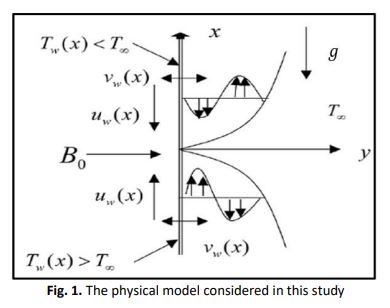Two-Dimensional Magnetized Mixed Convection Hybrid Nanofluid Over a Vertical Exponentially Shrinking Sheet by Thermal Radiation, Joule Heating, Velocity and Thermal Slip Conditions
DOI:
https://doi.org/10.37934/arfmts.95.2.159179Keywords:
Hybrid nanofluid, boundary layer, mixed convection, MHD, radiation, Joule heating, velocity slip, thermal slipAbstract
Hybrid nanofluid is an improved kind of nanofluid that typically utilized to enhance the thermal efficiency in fluid flow regimes. It has a wide range of real-world applications. This opened up many new prospects to further investigate the two-dimensional hybrid nanofluid under different body geometries and physical parameters. A numerical study of a two-dimensional magnetized mixed convection hybrid nanofluid flow over a vertical exponentially shrinking sheet is considered in this paper. The main objective of this current study is to examine the influences of volume fraction of copper, mixed convection, and radiation on the reduced skin friction and reduced heat transfer against the effect of suction. Besides, the influences of radiation, volume fraction of alumina, velocity slip, thermal slip, magnetic parameter, and Eckert number on the velocity and temperature profiles are also considered in this paper. The governing system of partial differential equations (PDEs) is transformed into a system of nonlinear ordinary differential equations (ODEs) through exponential similarity variables. Then, the bvp4c solver for MATLAB is used to solve the transformed nonlinear ODEs. Numerous significant results are being observed. As the quantity of mixed convection was raised, the reduced skin friction improved in both solutions, and reduced heat transfer increased in the second solution but with no variation found in the first solution. Besides, the temperature profile grew when the volume fraction of alumina, radiation, magnetic parameter, and Eckert number were raised in both solutions. In terms of heat transfer rate, when the amount of the velocity slip parameter was increased, temperature reduced in the first solution but increased in the second solution. Whilst temperature dropped in both solutions as the thermal slip parameter was enhanced. In conclusion, the addition of hybrid nanoparticles boosted the heat transmission rate. In the assisting flow condition, dual solutions exist when the suction parameter value is greater or equal to its critical point. However, no fluid flow is conceivable when the indicated value is less than this critical point.
Downloads
































